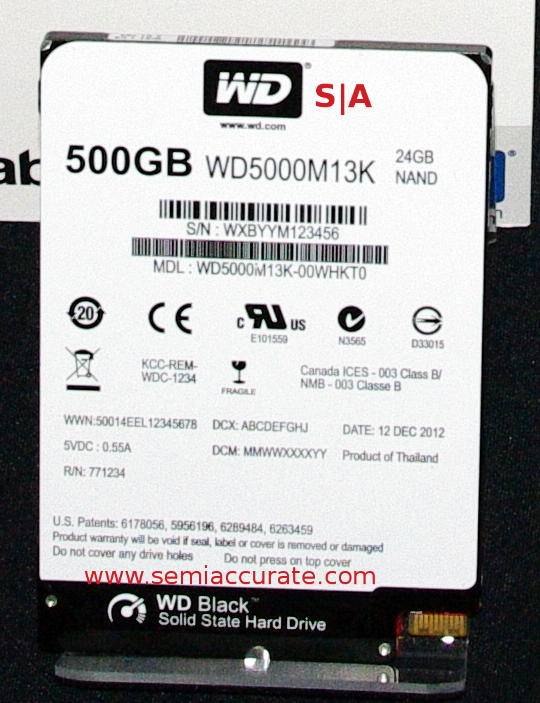WD Shows Off SSHD Hybrid 5mm Hard Drives
Western Digital is working on a 'hybrid' hard drive, a big hard drive mated with a little SSD
One of the biggest limitations of current Ultrabooks is the fact that most only feature a single drive bay which means that users can opt for either a fast, but expensive SSD or a slow and affordable mechanical hard drive. Western Digital new line of SSHD Black "hybrid hard drives" have a thickness of just 5 mm and may provide a solution to this problem.
SSHD stands for Solid State Hard Drive which isn't technically accurate since it is essentially a conventional 500 GB hard drive fused with 24 GB of NAND memory. When asked, WD said that the drive will need drivers to function, which makes us a little sad. Likely, since it'll need drivers, the NAND memory will only be usable as a caching SSD. We would like to see the NAND memory usable as a separate partition or drive so that one could install the OS to the NAND and get full SSD-esque performance for the OS, and have all the data on the slow HDD portion.
No word on availability or pricing, but seen as these drives are primarily aimed at Ultrabooks we can safely assume that these drives will be primarily released to OEMs only.
Get Tom's Hardware's best news and in-depth reviews, straight to your inbox.
Niels Broekhuijsen is a Contributing Writer for Tom's Hardware US. He reviews cases, water cooling and pc builds.
-
bgunner interesting Idea but i agree that being able to install the OS to the SSD part would be a greater benefit.Reply -
nukemaster fancarolinaSimply Western Digitals copy of the Seagate Momentus XT.But with MORE flash :) . The Momentus XT has SLC flash so it may well outlive the drive it self.Reply
The driver requirement honestly sucks because it may not work right with other operating systems.
I like the 5mm height. -
alextheblue fancarolinaSimply Western Digitals copy of the Seagate Momentus XT.No. They're actually quite different. Seagate's Momentus XT (I've got one) is not bad by any means (especially the newest models!), but it uses a much simpler caching method. The advantage of Seagate's approach is that it is done entirely on-drive and it is software-agnostic - meaning it works on any OS, and requires no drivers. In fact the OS will just think it is a regular mechanical HDD and treat it as such.Reply
The disadvantage is that the Momentus XT is not as good at knowing WHAT to cache. A driver-based solution will be similar to Intel's SRT caching system. It will be smarter, faster, and has a lot more cache to play with. In fact, given how good some of the caching systems are, I must disagree with the author's assertion that you'd get better performance by having complete manual control over the drive.
Think about it. If you install Windows on the tiny SSD, you've got a lot of files in that installation that aren't accessed regularly. That's a waste of precious cache, and leaves less room to cache installed programs! So instead of automatically caching most of your software's commonly accessed files, you're suggesting that we manually cache ALL of the files of a more limited number of programs? That leaves the rest to run ENTIRELY on the mechanical side.
Just let the caching system learn what it needs to keep in NAND and what to keep on the mechanical bit, and in regular daily use the system will have better overall performance. It might not be as fast at a particular task, but it will be better across the board. It also greatly simplifies space management. You could shove this drive in your parent's laptop, install the drivers, and they would be able to enjoy the speed boost without worrying about capacity.
If you really want no compromise, you either have to get a very large and expensive SSD, or get a larger laptop with dual bays. I actually lean towards the latter, myself, but most people don't have two bays, don't have tons of cash to burn, and have at least some space concerns. -
twelve25 You can't really run newer versions of Windows (or Mac OS) in 24GB anyway, so what's the diff if it's available separately?Reply
(okay, technically you could install it if you were really selective about what apps, patches and services you ran)
-
itzsnypah I think Intel should redefine their SSD policy in Ultrabooks. Something like 1:9 ratio of NAND:HDD GB or better.Reply
So in a 500GB model atleast 64GB would be NAND. Who cares if it drives up the price somewhat, a vastly superior experience would more than make up for the extra cost. -
neiroatopelcc Just get a seagate momentus instead! 750GB mechanical storage and 8GB SLC transparent SSD that caches the blocks of data you actually use a lot. They're working without special drivers by the way.Reply -
abbadon_34 Just port an existing hybrid raptor the 1.8" form factor and your done. Nothing special here.Reply

